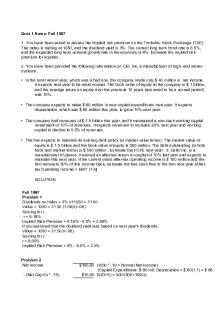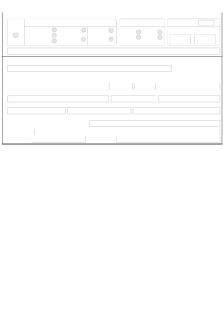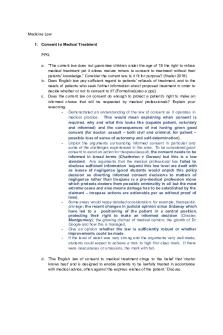Emergency medicine notes merged PDF

| Title | Emergency medicine notes merged |
|---|---|
| Author | Maryam J |
| Course | Emergency Medicine |
| Institution | Medical University-Pleven |
| Pages | 50 |
| File Size | 2.8 MB |
| File Type | |
| Total Downloads | 313 |
| Total Views | 969 |
Summary
EMERGENCY MEDICINE SYNOPSIS FOR STATE EXAMInter nsh ip Final Year Rotation Shock Violations of water-electrolyte equilibrium Violations of acid-alkaline equilibrium Cardiopulmonary resuscitation Clinical, biological and brain death Brain oedema Acute respiratory failure Acute renal failure Acute liv...
Description
EMERGENCY MEDICINE SYNOPSIS FOR STATE EXAM Internship Final Year Rotation 1. Shock 2. Violations of water-electrolyte equilibrium 3. Violations of acid-alkaline equilibrium 4. Cardiopulmonary resuscitation 5. Clinical, biological and brain death 6. Brain oedema 7. Acute respiratory failure 8. Acute renal failure 9. Acute liver failure 10. Diabetic ketoacidosis 11. Intensive therapy in peritonitis 12. Intensive therapy in ileus 13. Intensive therapy in pancreatitis 14. Intensive therapy in bleeding from gastrointestinal tract 15. Intensive therapy in acute myocardial infarction 16. Intensive therapy in multiple trauma 17. Intensive therapy in combustion 18. Intensive therapy in frost
46) Shock. Syndrome characterised by failure of heart to pump blood in sufficient quantity or pressure to maintain adequate tissue perfusion. Results in inadequate tissue perfusion to end organs such as brain, heart, liver, kidneys and abdominal viscera. Represents imbalance between oxygen demand and delivery, so with inadequate oxygen delivery, organs begin to fail and multiorgan-system dysfunction and death. Early on, shock is reversible with proper diagnosis and treatment. Stages Compensated: hypotension due to fall in CO or vasodilation. Compensatory mechanisms restore blood to vital organs. Signs are minimal and intervention is effective. Decompensated: insufficient compensation so reduced cerebral perfusion (altered sensorium), renal perfusion (urine output), CO (myocardial ischaemia). Signs and symptoms indicated excessive sympathetic discharge. Cyanosis, cold clammy skin, tachycardia and tachypnoea. Irreversible: critical and prolonged lowering of arterial pressure results in altered cell membrane, aggregation of RBCs and slugging of capillaries. Acute tubular necrosis, necrotic damage of gastric mucosa and absorption of bacteria and toxins. Endothelial damage with DIC ensues. Bacterial toxins release vasodilating peptides so further fall pressure, reduction in coronary perfusion resulting in further damage. Hypoxia, reduced neurogenic circulatory adjustments to maintain arterial pressure, loss of fluid and protein through capillaries, exacerbation of hypovolemia and hypotension resulting in cellular destruction.
Clinical signs Hypotension; absolute or relative to BP. Skin; pale, cool, moist, poor capillary filling, peripheral cyanosis. Pulse: rapid and thready. Urine output falls and extreme thirst.
Aetiological classification Cardiogenic shock: due to decreased myocardial contractility as a result of MI, dysrhythmias, drugs and myocarditis. Hypovolemic: due to haemorrhage, fluid loss (GI or renal), third space loss (surgery or anaphylaxis), vasodilator or diuretics. Hyperdynamic (vasodilatory): due to alteration in resistance or capacitance vessels causing vasodilation (as seen in septic shock by toxins, anaphylaxis or following spinal/epidural). Capillaries contain 6-7% total blood volume but can contain many times more when dilated. Microcirculation in shock Early stage (1): sympathetic stimulation results in increased precapillary tone so decreased hydrostatic pressure in microcirculation. Fluid moves from intracellular and interstitial spaces into circulation. Second stage (2): continued hypoperfusion causes anaerobic metabolism and lactic acidosis. Lowered pH reduces precapillary sphincter tone and increases postcapillary sphincter tone. Third stage (3): increased hydrostatic pressure due to perfusion results in transcapillary fluid loss into interstitial tissue.
Complications Cardiac decompensation, acute renal failure, progressive respiratory failure. Acute renal failure due to hypoxia and hypotension results in oliguria or high output failure. Respiratory failure from shock lung progressing to ARDS. May result from decreased lung perfusion, microinfarcts, or embolization. Hypovolemic shock Caused by decreased effective circulating blood volume and so inadequate ventricular preload. Most common cause is major blood loss from trauma, surgery or GI haemorrhage. Clinical manifestation: left ventricular end-diastolic volume and CO decrease due to decreased preload. In response to baroreceptor stimulation, heart rate increases to maintain CO. increased SNS outflow; constricts blood vessels, increases systemic vascular resistance and diverts blood from skin and muscle to brain and heart. So, patient appears cold and clammy with pale mucosa. Activation of renin-angiotensin system increases sodium reabsorption to restore circulating blood volume. Release of catecholamines from adrenals inhibits insulin secretion and induces gluconeogenesis. Results in increased plasma glucose to help restore circulating blood volume and increase osmotic gradient for fluid reabsorption into intravascular space. Cardiogenic shock Failure of either or both ventricles. When it fails, preload increases and ventricle cannot eject end-diastolic volume properly. This increases ventricular end-diastolic pressure, so ventricle becomes distended, hastening ventricular failure. Clinical manifestation: If right ventricle is initial site of failure, the increased right-sided preload presents as increased CVP, detected as distended neck veins, peripheral oedema or hepatic congestion. If left ventricle fails, increased preload detected as increased pulmonary capillary wedge pressure, causing cardiogenic pulmonary oedema and rales. Right ventricle eventually fails under increased pulmonary artery pressure afterload, and so biventricular failure occurs. In both scenarios, CO is low and systemic BP is reduced. To counteract hypotension, there is increased SNS outflow with resultant tachycardia and increased systemic vascular resistance. This compensatory mechanism increases blood flow to brain and failing ventricle but also increases myocardial oxygen demand; ultimately leads to worsening cardiac failure. Patient appears cool and pale due to high systemic vascular resistance and shunting of blood from skin and muscle. Vasodilatory shock Sepsis is most common cause; characterised by low afterload state where organ perfusion is impaired. Other causes are anaphylaxis and neurologic dysfunction such as stroke or spinal shock from high spinal cord injury. Often the final and common pathway for prolonged and severe hypotension resulting from late-stage shock from cardiogenic or hypovolemic shock etc. In all these conditions, there is markedly reduced afterload with redistribution of blood from highly perfused organs (brain, heart, liver, kidney) to large capacitance areas such as skin and skeletal muscles.
Clinical manifestation: compensation includes increase in CO by increasing stroke volume and heart rate. Initially, increased CO works. If left untreated, systemic vascular resistance continues to fall with worsening metabolic acidosis. Myocardial perfusion impaired and eventually progresses to cardiac failure. Patient appears warm and vasodilated with increased peripheral blood flow secondary to vasodilation in skin and muscle. However, in late, irreversible shock, extremities become cold and poorly perfused.
Sepsis and septic shock Final pathway of disseminated infection. Diagnosed by identifying source of infection, systemic inflammatory response and concomitant organ failure. Patient suffer overwhelming systemic inflammatory response with eventual multiple organ dysfunction and death. Essential for treatment is early recognition, rapid resuscitation, early administration of broad-spectrum antibiotics and prompt treatment of relevant infection.
Management of shock Administer O2, ventilation. Mental status, BP, heart rate and temperature determined. Foley catheter to monitor urine output; urine for analysis and culture. Large calibre peripheral or central venous line. Blood for grouping, crossmatching, culture and investigations. Correct primary problem (blood loss, anaphylaxis, septicaemia, cardiac instability). Fluids except in cardiogenic shock. Two IV lines necessary (one central if necessary). Management of hypovolemic shock: restore circulating blood volume and treat underlying cause when IV access and fluid therapy are achieved. Vasopressor therapy may be used but unsuccessful until intravascular volume restored. Management of cardiogenic shock: improve CO and decrease afterload. Interventions allow ventricle to eject more efficiently, decrease myocardial work and oxygen consumption and reverse progression to cardiac failure. Monitor direct arterial and CVP to oversee treatment. ECG and pulmonary artery catheter measurements taken to aid treatment. Diuretics generally indicated by used sparingly to avoid worsening the hypotension. Afterload and preload reduced with vasodilators and venodilators like (nicardipine, nitroglycerine or nitroprusside). For inotropy, dobutamine improves CO and reduces afterload with minimal increase in myocardial oxygen demand. Can also use intra-aortic balloon counter-pulsation (IABP) and ventricular assist devices (VADs). For RHF, goal is to reduce afterload with pulmonary vasodilators (nitroglcyerine, dobutamine and inhaled nitric oxide). IABP for RHF improves coronary perfusion to right side. Management of vasodilatory shock: IV fluid therapy until adequate preload (CVP 812cmH2O). Vasopressors (phenylephrine, dopamine, epinephrine, norepinephrine) added if patient remains hypotensive to increase systemic vascular resistance and CO.
Inotropic drugs and vasopressors Dopamine: both direct and indirect agonist at dopamine 1, b1 and a1 receptors. At small (0-5µg/kg/min) dose, has mainly DA1 receptor agonist activity; dilation of renal arteries, promotes diuresis. At moderate (5-10µg/kg/min) dose, b1-adrenergic effects dominate. Cause increase in myocardial contractility, heart rate and CO. so myocardial oxygen demand also increases; more than delivery so myocardial ischaemia develops. At large (10-20µg/kg/min) dose, a1-agonist effects predominate and dopamine increases vascular smooth muscle tone, which increases systemic vascular resistance. This causes decrease in splanchnic and renal blood flow, similar to effects of large-dose phenylephrine. At all doses, mediates indirect release of norepinephrine, responsible for tachycardia seen in some patients after administration. Epinephrine: direct stimulation of a1, b1 and b2 receptors. At lower doses, acts as b-receptor agonists whereas at higher doses, has increasing a1 receptor effects. Increases in heart rate, myocardial activity and CO reflect b1 receptor effects. Principal b2 receptor effects are bronchial and vascular smooth muscle relaxation. With larger doses, a1 receptor effects increase systemic vascular resistance and reduce splanchnic and renal blood flow while maintaining both cerebral and myocardial perfusion pressure. Also has anti-inflammatory effects by blocking release of inflammatory mediators from mast cells and basophils. B-activation in liver and skeletal muscle cells leads to increased gluconeogenesis via adenylate cyclase pathway. Both action lead to increase in blood glucose levels. Main indications are management of cardiac arrest, severe cardiogenic shock and anaphylactic reactions. When given as continuous infusion. Usual range is 1-20µg/min. However, in lifethreatening shock, necessary to administer in even larger doses. Norepinephrine: direct-acting adrenergic agonist with a1 and b1 receptor activity. Similar to epinephrine but lacks b2 receptor effect and as much stronger a1 receptor activity. Increases arterial blood pressure through a1 effects on systemic vascular resistance. B1 effects contribute to increased myocardial contractility and CO. Used for treatment of septic shock. B1 activity may offset myocardial dysfunction in severe sepsis/septic shock/. Vasopressor of choice in septic shock. Must be given in continuous infusion as typical range is 1-20µg/min. At lower end of this range, there are more b1 effects whereas a1 activity dominates in larger doses.
Phenylephrine: direct-acting, highly selective a1-receptor agonist; increases systemic vascular resistance and arterial BP. No direct effect on myocardial function, but can cause reflex bradycardia which may decrease CO. Used to treat septic and vasodilatory shock by increasing systemic BP. Can cause splanchnic ischaemia when used chronically in large doses. Improves cerebral perfusion in brain injury patients even though it does not cross BBB (no effect on cerebral vasculature); does so by increasing systemic BP. Typical range is up to 200µg/min. Larger doses have little therapeutic effect and worsen splanchnic ischaemia. Dobutamine: mixed b1 and b2-receptor agonist. Primary effect is increased heart rate and myocardial contractility. Also, relaxes vascular smooth muscle by binding at b2 receptors. Acts to increase CO by improving ventricular function (b1) and vascular resistance (b2). Used for treatment of cardiogenic shock with high afterload and low CO. Due to b2 effects, some patients become hypotensive (especially those with decreased intravascular volume). However, it has short half life so effects rapidly disappear. Given in continuous infusion; usual dose range is 1-20µg/kg/min. Vasopressin: potent vasoconstrictor. Binds to peripheral vasopressin receptors to induce vasoconstriction. Useful alternative to catecholamines (which do not function well in profound acidaemia). Vasopressin is effective even in severe acidosis. Sepsis/septic shock patients are sensitive to its effects and usual dose range is reduced. For septic shock, recommended to infuse at 0.04U/min. If patient improves, discontinue vasopressin, do not wean. Used for cardiogenic shock. Patients recently weaned from cardiopulmonary bypass may remain hypotensive secondary to low afterload state. These patients also have relative vasopressin deficiency, so vasopressin used to treat this vasodilatory shock. In these patients, dose of 0.1U/min is significantly larger than in septic shock.
47) Fluid balance. Fluid management. Intracellular volume (ICV) is 40% of body weight. ECV is 20% so total body water (TBW) is 60%. Plasma volume is 1/5th of ECV, and remainder is interstitial fluid volume (IFV). Red cell volume (2l) is part of ICV. Distribution volume of Na-free water is TBW. Distribution volume of infused Na is ECV (qual concentrations in plasma volume and interstitial fluid). Plasma [Na+] is 140mEq/l. Intracellular [K+] is 150mEq/l. Albumin is unequally distributed; plasma 40g/l and IFV 10g/l. ECV is distribution volume for colloid solutions. TBW content regulated by in-/output of water. Water intake includes liquids plus 750ml in solid food and 350ml generated metabolically. Insensible loss (sweating, respiring etc.) is 1l a day. GI losses are 100-150ml/day. Thirst is triggered by increased in fluid tonicity or decrease in ECV. Reabsorption of water and Na mediated by ADH, atrial natriuretic peptide and aldosterone. Two hormonal systems regulate total body sodium: natriuretic peptides (ANP, BNP, and C-type NP) defend against Na overload. RAAS defends against Na depletion and hypovolaemia. Aldosterone is final common pathway in response to decreased effective arterial volume.
Osmotically active particles attract water across semipermeable membranes until equilibrium. The osmolarity of solution is the number of osmotically active particles per litre of solvent; the osmolality is a measurement of the number of osmotically active particles per kg. Hyperosmolar state occurs when concentration of osmotically active particles is high. Uraemia (increased BUN) and hypernatremia (increased serum Na) increase serum osmolality. However, because urea distributes throughout TBW, increase in BUN does not cause hypertonicity. Sodium does cause hypertonicity because it is restricted to ECV. Tonicity compares osmotic pressure of solution to that of plasma. Plasma proteins are essential in determining equilibrium of fluid between interstitial and plasma parts of ECV. Fluid management Fluids divided into crystalloids and colloids. Crystalloids are low molecular weight aqueous solutions with or without glucose. Colloids are high molecular weight, maintain plasma oncotic pressure and remain intravascular for hours. Water loss replaced with hypotonic solutions like 5% glucose solution. Water and electrolyte loss replaced with isotonic 1/2
3-6h). Indications are haemorrhagic shock awaiting blood and fluid resuscitation in severe hypoalbuminemia or protein losses (burns).
Crystalloids 131mEq/l Na+, 112mEq/l Cl-, 2mEq/l Ca2+ and 29mEq/l bicarbonate as lactate. Best for Normal saline 0.9% NaCl isotonic solution. Contains 154mEq/l Na+ and 154mEq/l Cl-. Preferred for treating hypochloremic metabolic alkalosis, hyponatraemia and brain injury. + , and 36mEq/l K+. Used to replace liquid loss from diarrhoea. Glucose solutions are isotonic but become hypotonic with metabolism of glucose in the body. Colloids Dextrans are polysaccharides. Used as a plasma expander. Small MW solution dextran improves tissue perfusion by opening microcirculation. May inhibit anti-platelet effects, antigenicity and cause anaphylactic reaction. Large MW dextrans block renal tubules. Can interfere with blood grouping and crossmatching due to red cell aggregation. Gelatins also plasma expanders. Do not interfere with blood grouping, platelet function and no severe anaphylactic reactions. Citrated blood should not be mixed with gelatins because they contain Ca. Hydroxyethyl starch; 6% and 10% solution. Prolonged half life and expand plasma for hours. Improve microcirculation and so improves O2 delivery in tissues. Blood usually transfused as replacement when lost. Check bottle has been grouped and crossmatched. Plasma is useful as plasma expander. Reconstituted dried plasms from pool of several donors. Requires crossmatching. Albumin (5% and 20%) used to increase plasma proteins; less hazardous than plasma. No crossmatching required. Hypersensitivity possible.
Aim of fluid and electrolyte administration by IV infusion is to maintain water and electrolyte balance when loss has occurred. Loss of water in 60kg adult: urine 1000ml, lungs 400ml, skin 900ml, stool 200ml. Total loss of water/day 2500ml. Excess fluid loss occurs though: exudation and evaporation in burns, GIT (vomiting, diarrhoea, fistulae), kidney, haemorrhage, third space loss due to sequestration after trauma and surgery. Adequacy of fluid and acid-base balanced assessed by: heart rate, BP, CVP, urinary output, haematocrit, electrolytes, osmolarity, ABG. Fluids in clinical situations: Renal failure: colloids preferred (start with 30% of requirement then transfuse as per CVP). Liver failure: Albumin preferred. ARDS: Initially crystalloids. Colloids only after 48 hours. st
24h at rate of 4ml/kg/% of body burnt. 50% of this fluid in 8 hours then remaining in next 16 hours. Colloids (especially albumin) added for 2nd day.
48) Electrolytes. Sodium (normal level 135-145mEq/l) Na+ essential for generation of action potentials in neurologic/cardiac tissues. Disorders of total body sodium associated with increases/decreases of ECV and plasma volume. Hypo/hypernatremia result from excess or loss of water respectively. Regulation of total body sodium and [Na+] is by endocrine and renal systems. Aldosterone and ANP control total body sodium. ADH, secreted in response to increased osmolality or decreased BP, regulates [Na+]. So, hyperaldosteronism is associated with hypervolemia and hypertension but not abnormal [Na+]. Hyponatremia (30x greater than extracellular [K+]. Intracellular [K+] normally 150mEq/l while extracellular is 3.55mEq/l. Regulators of K+ excretion are plasma [K+] and aldosterone. Hypokalaemia (6mEq/l corrected before elective procedures. Dialysis during treatment. Always consider hyperkalaemia when renal failure patient suffers cardiac arrest. Treatment: Threefold. Treat cardiotoxicity with IV CaCl2. K+ can be shifted intracellularly by -adrenergic stimulation, sodium bicarbonate and insulin. Body excretion takes long but done by diuretics and dialysis.
49) Acid-base abnormalities. May be respiratory or metabolic based on arterial pH, pCO 2 and HCO3-. Blood gas sample: arterial sample taken from radial or femoral artery. Normal blood gas analysis: pH: 7.35-7.45 ...
Similar Free PDFs

Emergency medicine notes merged
- 50 Pages

Emergency medicine key conditions
- 62 Pages

Merged Marine Biology Notes
- 53 Pages

Family Medicine Notes
- 20 Pages

Pharmaceutical Medicine Notes
- 68 Pages

CCP-merged - Lecture notes 1,3,7
- 36 Pages

Medicine
- 11 Pages

Merged (pdf
- 9 Pages

Ilovepdf merged
- 5 Pages

Merged document
- 210 Pages

Medicine Full Lecture Revision Notes
- 112 Pages

sk3 emergency
- 1 Pages
Popular Institutions
- Tinajero National High School - Annex
- Politeknik Caltex Riau
- Yokohama City University
- SGT University
- University of Al-Qadisiyah
- Divine Word College of Vigan
- Techniek College Rotterdam
- Universidade de Santiago
- Universiti Teknologi MARA Cawangan Johor Kampus Pasir Gudang
- Poltekkes Kemenkes Yogyakarta
- Baguio City National High School
- Colegio san marcos
- preparatoria uno
- Centro de Bachillerato Tecnológico Industrial y de Servicios No. 107
- Dalian Maritime University
- Quang Trung Secondary School
- Colegio Tecnológico en Informática
- Corporación Regional de Educación Superior
- Grupo CEDVA
- Dar Al Uloom University
- Centro de Estudios Preuniversitarios de la Universidad Nacional de Ingeniería
- 上智大学
- Aakash International School, Nuna Majara
- San Felipe Neri Catholic School
- Kang Chiao International School - New Taipei City
- Misamis Occidental National High School
- Institución Educativa Escuela Normal Juan Ladrilleros
- Kolehiyo ng Pantukan
- Batanes State College
- Instituto Continental
- Sekolah Menengah Kejuruan Kesehatan Kaltara (Tarakan)
- Colegio de La Inmaculada Concepcion - Cebu



